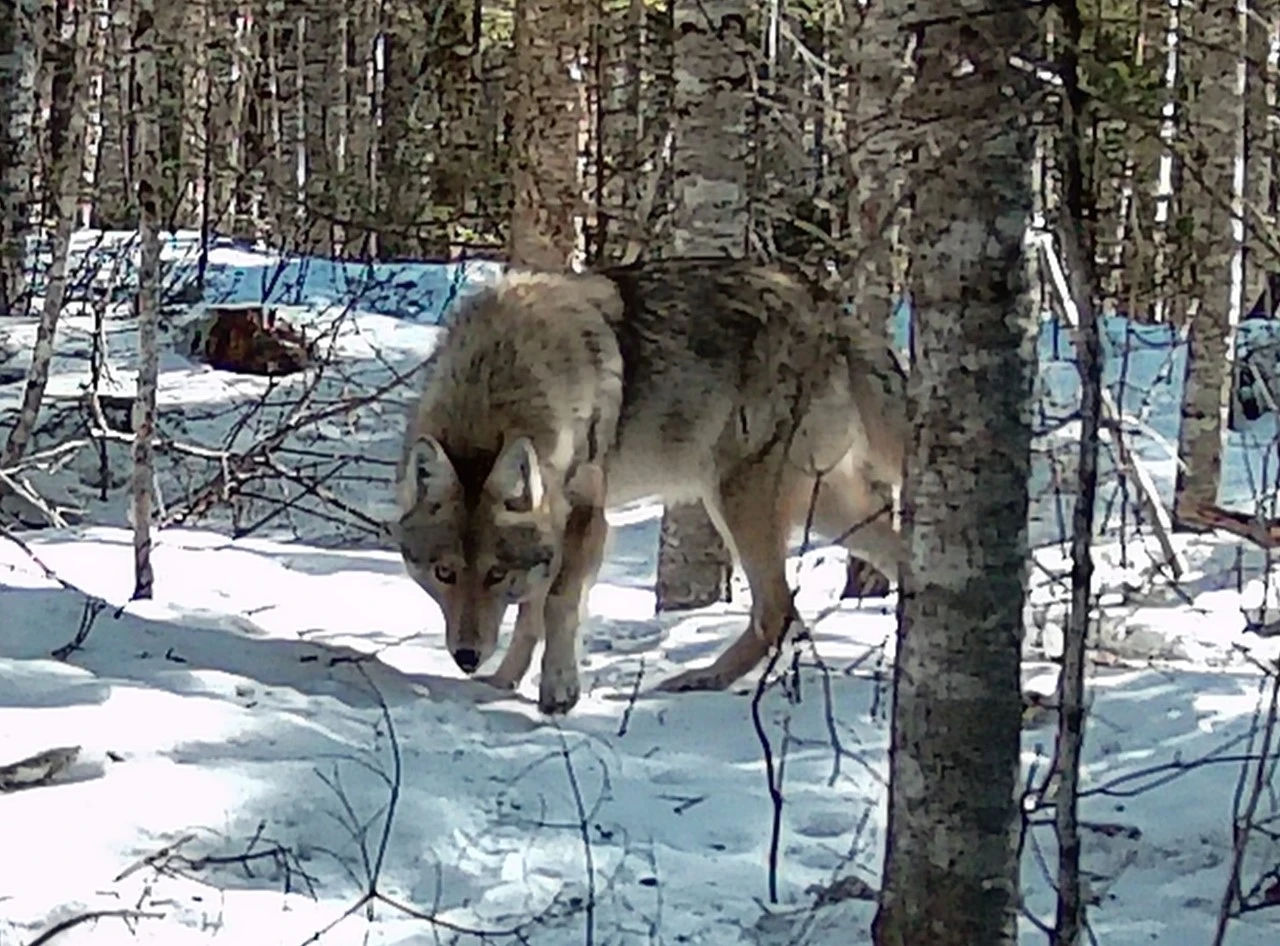
The presence of wolves in Maine is hotly debated after they were extirpated from the Northeast due to centuries of bounties, habitat alteration and development. But with evidence of a possible wolf roaming the trails, researchers must turn to poop, or scat, to really understand if they’ve returned.
Differentiating between different canid species can be challenging, especially from visual observations or scat analysis alone. Wolves, coyotes and domestic dogs can have overlapping characteristics, and hybridization between these species can further complicate identification.
John Glowa, the founder of Maine Wolf Coalition (MWC), says differentiating between a wolf, a coyote and a hybrid animal on a trail camera is complicated. “We acknowledge the only way to be certain is through DNA,” Glowa told the Portland Press Herald, “but the evidence we have collected certainly points to an Eastern wolf.”
Some of that evidence is scat samples, which were analyzed in 2020. In addition to deploying trail cameras and pouring over footage looking for wolf-like animals, Glowa and a small team of volunteers have been collecting scat for noninvasive genetic sampling. Wolves In Maine
By extracting DNA from scat, it’s possible to identify individual genotypes — the set of genetic material that makes up an organism and can therefore identify it. Scat can tell us what trail camera footage cannot. It can reveal, for example, if the animal is a straight wolf or coyote, or if it has mixed ancestry. This is important since wolves and coyotes can and do interbreed and produce fertile offspring.
It’s also important because knowing the animal’s genetics affects how the State manages it, and, in the case of an endangered species like the wolf, the federal government.
Researchers analyzed the samples against a reference database that included genotypes for grey wolves from Northwest Territories, Great Lakes-Boreal wolves from Northeastern Ontario, Eastern wolves from Algonquin Park, Eastern coyotes from southern Ontario, and domestic dogs.
Results of Wolf Scat Samples
Of the 11 samples, six were identified as Eastern coyote, four were not assigned an ancestry due to the quality of the sample, and one received an ancestry assignment value of 0.84 to Eastern wolf. To Glowa, this was the confirmation he’d been hoping for. “Eighty-four percent is a very high percentage, and we would not consider it a hybrid,” he recently told a reporter at the Bangor Daily News.
However, not everyone agrees that it is absolutely a wolf. State and federal wildlife managers consider the animal a hybrid.
Categorically stating this animal is a wolf or, more specifically, an Eastern wolf, based on the scat analysis also doesn’t sit well with some scientists. One researcher at Trent University encouraged “extreme caution” when interpreting these results, and the report itself states that “this sample was missing [two] of the 12 loci used for assignment.”
A United States Fish and Wildlife Service forensic scientist observed that “the missing data definitely affects the 84 percent number,” although the scientist was unable to say in which direction.
Challenges of Analyzing Wolf DNA
The challenge with scat samples is that the DNA is degraded and that limits the researcher’s ability to sequence long sections of the genome.
“I view ancestry percentages with extreme caution,” says Kristin Brzeski, assistant professor in the College of Forest Resources and Environmental Science at Michigan Technological University and principal investigator at the Brzeski Conservation Genetics Lab. Brzeski is now in possession of more than 200 scat samples submitted to her lab by MWC.
Brzeski likens it to the genetic testing company 23andMe. They tell customers that their results are expected to change in subsequent reports from the company based on a variety of factors including the reference populations used to predict ancestry.
“It’s not because they were wrong,” Brzeski explains. “It’s because their references changed, and the analysis they are doing with those references changed.”
When it comes to a scat sample, Brzeski is much more comfortable saying an animal has mixed ancestry instead of giving percentages, especially if one is a high number.
“Scat can tell us that,” Brzeski says, “and then genomic data can resolve it more completely.”
More Research on Wolf Ancestry
So, why not just get the genomic data in the first place — why not get the data that can confirm with a high degree of certainty if the animal is a wolf or not (and avoid dealing with all that poop)?
The trouble with genomic data is that to get it, researchers need to handle the animal. They must either trap it and draw blood or take a tissue sample. Or they need a sample from a dead animal, either killed by a hunter or hit by a car. While invasive genetic sampling provides a greater depth of information about the animal, it is more challenging, more expensive and usually yields far fewer samples than noninvasive genetic testing.
This is especially true if little is known about the population, as is the case in the Northeast, and this is where noninvasive sampling shines. If done properly, it can help provide the big picture, landscape level assessment of the State’s canid population and inform a roadmap for future, more targeted noninvasive sampling and, if necessary, invasive sampling at some point down the road.
MWC is hopeful they can raise the funds to get the samples already at Brzeski’s Lab analyzed soon. This round of scat sampling is probably not a silver bullet that will definitively answer the question of whether wolves are returning to the Northeast in a way that requires protection under the Endangered Species Act.
But it will likely be an important first step toward a more data-driven dialog that will inform future work and bring more stakeholders to the table.

